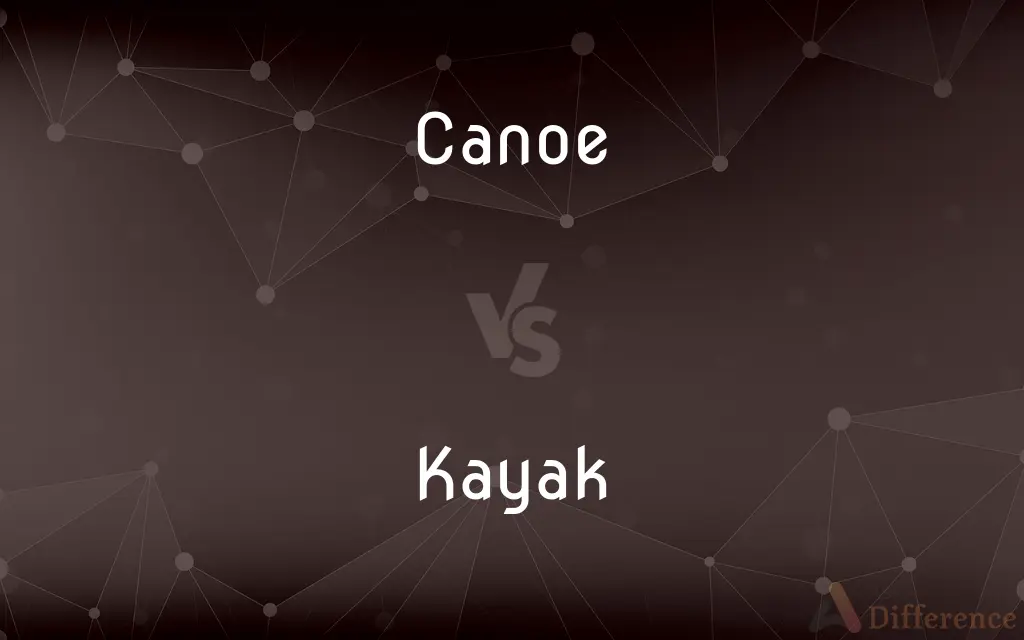Canoe vs. Kayak — What's the Difference?
Edited by Tayyaba Rehman — By Maham Liaqat — Updated on March 14, 2024
Canoes are open vessels propelled by one or more paddlers using single-bladed paddles, while kayaks are enclosed, often with a cockpit, and use a double-bladed paddle.

Difference Between Canoe and Kayak
Table of Contents
ADVERTISEMENT
Key Differences
Canoes feature an open deck, providing a spacious area for gear and multiple paddlers, making them ideal for leisurely trips and fishing. On the other hand, kayaks are characterized by their closed decks, which offer better protection against water and elements, making them well-suited for more adventurous activities like sea kayaking and whitewater rapids.
While canoes typically allow for a kneeling or sitting position, offering greater stability and comfort during long journeys, kayaks require paddlers to sit with their legs extended forward, which can enhance control and power in rough waters.
Canoes often have a higher profile, making them more susceptible to wind but also providing more room for storage, making them preferable for activities like camping trips. Kayaks, with their lower profile, are less affected by wind and are easier to maneuver, which is advantageous in challenging conditions such as ocean waves or whitewater.
In terms of paddling technique, canoeists use single-bladed paddles and switch sides to steer and propel the boat. Kayakers use double-bladed paddles, allowing for a more efficient and continuous stroke on both sides of the kayak.
Canoes and kayaks differ in their cultural and historical contexts as well. Canoes have a rich heritage among indigenous peoples, especially in North America, serving as a vital means of transportation and hunting. Kayaks, originating from the Arctic regions, were primarily used by Inuit and Aleut hunters for navigating icy waters and hunting.
ADVERTISEMENT
Comparison Chart
Design
Open deck
Enclosed deck with cockpit
Seating Position
Kneeling or sitting on a bench
Sitting with legs extended
Paddle Type
Single-bladed
Double-bladed
Susceptibility to Wind
Higher due to open design and higher profile
Lower due to enclosed design and lower profile
Typical Use
Leisure, fishing, camping
Sea kayaking, whitewater, touring
Compare with Definitions
Canoe
A canoe is an open vessel, allowing for easy access and flexibility in cargo and seating arrangements.
The family enjoyed a leisurely paddle in their open canoe, basking in the sunshine.
Kayak
Kayaks feature an enclosed deck, often with a cockpit, providing protection from water.
Her kayak's enclosed deck kept her dry as she navigated the choppy sea.
Canoe
Canoeists use single-bladed paddles and may switch sides to maintain direction.
He skillfully maneuvered the canoe with his single-bladed paddle, gliding across the lake.
Kayak
Kayakers use a double-bladed paddle for efficient propulsion and steering.
With each stroke of his double-bladed paddle, he moved swiftly through the river's rapids.
Canoe
Canoes often allow for a kneeling or bench seating position, offering comfort and versatility.
She preferred the traditional kneeling position in her canoe, feeling a deeper connection to the water.
Kayak
In a kayak, paddlers sit with their legs extended forward, which can aid in control and maneuverability.
The snug fit of the kayak allowed him to control the boat using his extended legs.
Canoe
The higher profile of canoes can catch more wind but also allows for more storage space.
Their canoe, laden with camping gear, stood tall against the gentle breeze.
Kayak
The lower profile of a kayak offers less wind resistance and is ideal for more challenging conditions.
Her low-profile kayak cut smoothly through the water, unaffected by the gusting wind.
Canoe
Canoes hold significant historical and cultural value, especially among indigenous North American communities.
The handcrafted canoe, a symbol of heritage, glided through the waters of the serene lake.
Kayak
Kayaks have their roots in Arctic regions, used historically by Inuit for hunting and transportation.
The sleek design of his kayak echoed the ingenuity of its Arctic ancestors.
Canoe
A canoe is a lightweight narrow water vessel, typically pointed at both ends and open on top, propelled by one or more seated or kneeling paddlers facing the direction of travel and using a single-bladed paddle.In British English, the term "canoe" can also refer to a kayak, while canoes are then called Canadian or open canoes to distinguish them from kayaks. Canoes were developed by cultures all over the world, including some designed for use with sails or outriggers.
Kayak
A kayak is a small, narrow watercraft which is typically propelled by means of a double-bladed paddle. The word kayak originates from the Greenlandic word qajaq (IPA: [qajɑq]).
Canoe
A light, slender, usually open boat that has pointed ends and is propelled by paddles.
Kayak
A canoe of a type used originally by the Inuit, made of a light frame with a watertight covering having a small opening in the top to sit in.
Canoe
To carry or send by canoe.
Kayak
Travel in or use a kayak
The centre is ideal for kayaking
Canoe
To travel in or propel a canoe.
Kayak
A very light, slender, usually covered boat that has pointed ends and is propelled by a double-bladed paddle. Traditional Yupik and Inuit kayaks are made of skins stretched over a frame of wood or whalebone.
Canoe
A small long and narrow boat, propelled by one or more people (depending on the size of canoe), using single-bladed paddles. The paddlers face in the direction of travel, in either a seated position, or kneeling on the bottom of the boat. Canoes are open on top, and pointed at both ends.
Kayak
To go, travel, or race in a kayak.
Canoe
(slang) An oversize, usually older, luxury car.
Kayak
To go or travel on (a body of water) by kayak
Kayaked rapids of the Colorado River.
Canoe
(gambling) Any of the deflectors positioned around a roulette wheel, shaped like upside-down boats.
Kayak
A type of small boat, covered over by a surface deck, powered by the occupant or occupants using a double-bladed paddle in a sitting position, from a hole in the surface deck
Canoe
To ride or paddle a canoe.
Kayak
(intransitive) To use a kayak, to travel or race in a kayak.
Kayaking is an Olympic sport.
Canoe
A boat used by rude nations, formed of trunk of a tree, excavated, by cutting of burning, into a suitable shape. It is propelled by a paddle or paddles, or sometimes by sail, and has no rudder.
Others devised the boat of one tree, called the canoe.
Kayak
(transitive) To traverse (a body of water) by kayak.
On a dare, he kayaked the Harlem River in New York from Hell's Gate to Spyten Duyvil.
Canoe
A boat made of bark or skins, used by savages.
A birch canoe, with paddles, rising, falling, on the water.
Kayak
A light canoe, made of skins stretched over a frame, and usually capable of carrying but one person, who sits amidships and uses a double-bladed paddle. It is peculiar to the Eskimos and other Arctic tribes.
Canoe
A light pleasure boat, especially designed for use by one who goes alone upon long excursions, including portage. It it propelled by a paddle, or by a small sail attached to a temporary mast.
Kayak
A small canoe consisting of a light frame made watertight with animal skins; used by Eskimos
Canoe
To manage a canoe, or voyage in a canoe.
Kayak
Travel in a small canoe;
We kayaked down the river
Canoe
Small and light boat; pointed at both ends; propelled with a paddle
Canoe
Travel by canoe;
Canoe along the canal
Common Curiosities
Can you fish from a kayak or a canoe?
Yes, both can be used for fishing, but canoes offer more space and stability, which might be preferable for some anglers.
Can canoes handle rough water like kayaks?
While canoes can handle moderate rough water, kayaks are better suited for very rough conditions such as whitewater or sea kayaking due to their enclosed design and lower profile.
What is the main difference between a canoe and a kayak?
The main difference lies in their design; canoes are open-decked and usually propelled with single-bladed paddles, while kayaks are enclosed and use double-bladed paddles.
Is it easier to tip over in a canoe or a kayak?
Kayaks are generally more stable and less likely to tip over due to their low center of gravity and enclosed design.
Which is easier for beginners, canoeing or kayaking?
Many find kayaking easier to pick up due to its more intuitive paddling technique and the kayak's stability.
Are kayaks faster than canoes?
Generally, kayaks are faster and more agile due to their sleek design and double-bladed paddles, making them efficient in various water conditions.
Are kayaks more comfortable than canoes?
Comfort is subjective and depends on personal preference; kayaks offer a snug fit and support, while canoes provide more room to move and change positions.
Can both kayaks and canoes be used in the ocean?
Yes, but kayaks are often better suited for ocean use due to their ability to handle waves and wind more effectively.
How do the seating positions in canoes and kayaks affect paddling?
The seating position in canoes allows for more powerful strokes and easier switching sides, while the seated position in kayaks offers more control and efficiency in stroke.
Can both kayaks and canoes be used for camping trips?
Yes, both can be used for camping, but canoes often offer more space for gear.
How do the cultural histories of canoes and kayaks differ?
Canoes have a rich history among North American indigenous peoples, while kayaks were developed by the Inuit and Aleut peoples of the Arctic for hunting and transportation.
Are there different types of kayaks and canoes for various activities?
Yes, there are specialized designs for both kayaks and canoes tailored to specific activities such as racing, fishing, whitewater, and touring.
Can both canoes and kayaks be used in rivers?
Yes, both are suitable for river use, but the choice depends on the river's conditions and the paddler's preference.
Do canoes or kayaks offer better exercise?
Both offer good workouts, but kayaking may engage the upper body and core more intensively due to the use of a double-bladed paddle.
Which is better for solo paddling, a canoe or a kayak?
Kayaks are generally preferred for solo paddling due to their ease of maneuverability and control.
Share Your Discovery

Previous Comparison
Spot vs. Blemish
Next Comparison
Ghost vs. ShadowAuthor Spotlight
Written by
Maham LiaqatEdited by
Tayyaba RehmanTayyaba Rehman is a distinguished writer, currently serving as a primary contributor to askdifference.com. As a researcher in semantics and etymology, Tayyaba's passion for the complexity of languages and their distinctions has found a perfect home on the platform. Tayyaba delves into the intricacies of language, distinguishing between commonly confused words and phrases, thereby providing clarity for readers worldwide.
















































